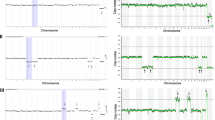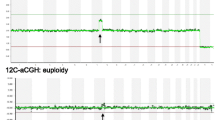Abstract
Purpose
To compare single nucleotide polymorphism (SNP) and comparative genomic hybridization (aCGH) microarray platforms to evaluate embryos for parental translocation imbalances and aneuploidy.
Methods
A retrospective review of preimplantation genetic diagnosis and screening (PGD/PGS) results of 498 embryos from 63 couples undergoing 75 in vitro fertilization cycles due to parental carriers of a reciprocal translocation.
Results
There was no significant difference between SNP and aCGH microarrays when comparing the prevalence of embryos that were euploid with no translocation imbalance, euploidy with a parental translocation imbalance or aneuploid with or without the parental chromosome imbalance. The clinical pregnancy rates were also equivalent for SNP (60 %) versus aCGH (65 %) microarrays. Of 498 diagnosed embryos, 45 % (226/498) were chromosomally normal without translocation errors or aneuploidy, 22 % (112/498) were euploid but had a parentally derived unbalanced chromosomal segregant, 8 % (42/498) harbored both a translocation imbalance and aneuploidy and 24 % (118/498) of embryos were genetically balanced for the parental reciprocal translocation but were aneuploid for other chromosomes. The overall clinical pregnancy rate per IVF cycle following SNP or aCGH microarray analysis was 61 % and was higher if the biopsy was done on blastocysts (65 %) versus cleavage stage embryos (59 %), although not statistically significant.
Conclusions
SNP or aCGH microarray technologies demonstrate equivalent clinical findings that maximize the pregnancy potential in patients with known parental reciprocal chromosomal translocations.
Similar content being viewed by others
References
Gardner RJM, Sutherland GR. Chromosome abnormalities and genetic counseling. 3rd ed. Oxford University Press; 2004.
Sax K. The time factor in X-Ray production of chromosome aberrations. Proc Natl Acad Sci U S A. 1939;25(5):225–33.
Fryns JP, Van Buggenhout G. Structural chromosome rearrangements in couples with recurrent fetal wastage. Eur J Obstet Gynecol Reprod Biol. 1998;81(2):171–6.
Robert L. Nussbaum MD, McInnes RR, Huntington F. Willard PD. Thompson & Thomspon Genetics in Medicine. 7th ed. Elsevier Science Health Science Division; 2007.
Chen CP, Wu PC, Lin CJ, Chern SR, Tsai FJ, Lee CC, et al. Unbalanced reciprocal translocations at amniocentesis. Taiwan J Obstet Gynecol. 2011;50(1):48–57.
Escudero T, Estop A, Fischer J, Munne S. Preimplantation genetic diagnosis for complex chromosome rearrangements. Am J Med Genet A. 2008;146A(13):1662–9.
Grati FR, Barlocco A, Grimi B, Milani S, Frascoli G, Di Meco AM, et al. Chromosome abnormalities investigated by non-invasive prenatal testing account for approximately 50 % of fetal unbalances associated with relevant clinical phenotypes. Am J Med Genet A. 2010;152A(6):1434–42.
Treff NR, Northrop LE, Kasabwala K, Su J, Levy B, Scott Jr RT. Single nucleotide polymorphism microarray-based concurrent screening of 24-chromosome aneuploidy and unbalanced translocations in preimplantation human embryos. Fertil Steril. 2011;95(5):1606–12.
Lim CK, Cho JW, Song IO, Kang IS, Yoon YD, Jun JH. Estimation of chromosomal imbalances in preimplantation embryos from preimplantation genetic diagnosis cycles of reciprocal translocations with or without acrocentric chromosomes. Fertil Steril. 2008;90(6):2144–51.
Beyazyurek C, Ekmekci CG, Saglam Y, Cinar C, Kahraman S. Preimplantation genetic diagnosis (PGD) for extremes–successful birth after PGD for a consanguineous couple carrying an identical balanced reciprocal translocation. Fertil Steril. 2010;93(7):1–5.
Huang J, Lian Y, Qiao J, Chen Y, Ren X, Liu P. Characteristics of embryo development in Robertsonian translocations' preimplantation genetic diagnosis cycles. Prenat Diagn. 2009;29(12):1167–70.
Ko DS, Cho JW, Park SY, Kim JY, Koong MK, Song IO, et al. Clinical outcomes of preimplantation genetic diagnosis (PGD) and analysis of meiotic segregation modes in reciprocal translocation carriers. Am J Med Genet A. 2010;152A(6):1428–33.
Kuliev A, Verlinsky Y. Current features of preimplantation genetic diagnosis. Reprod BioMed Online. 2002;5(3):294–9.
Munne S. Analysis of chromosome segregation during preimplantation genetic diagnosis in both male and female translocation heterozygotes. Cytogenet Genome Res. 2005;111(3–4):305–9.
Munne S, Morrison L, Fung J, Marquez C, Weier U, Bahce M, et al. Spontaneous abortions are reduced after preconception diagnosis of translocations. J Assist Reprod Genet. 1998;15(5):290–6.
Munne S, Sandalinas M, Escudero T, Fung J, Gianaroli L, Cohen J. Outcome of preimplantation genetic diagnosis of translocations. Fertil Steril. 2000;73(6):1209–18.
Otani T, Roche M, Mizuike M, Colls P, Escudero T, Munne S. Preimplantation genetic diagnosis significantly improves the pregnancy outcome of translocation carriers with a history of recurrent miscarriage and unsuccessful pregnancies. Reprod BioMed Online. 2006;13(6):869–74.
Harper JC, Wilton L, Traeger-Synodinos J, Goossens V, Moutou C, SenGupta SB, et al. The ESHRE PGD Consortium: 10 years of data collection. Hum Reprod Update. 2012;18(3):234–47.
Fragouli E, Wells D. Aneuploidy screening for embryo selection. Semin Reprod Med. 2012;30(4):289–301.
Dierssen M, Herault Y, Estivill X. Aneuploidy: from a physiological mechanism of variance to down syndrome. Physiol Rev. 2009;89(3):887–920.
Wapner RJ. Genetics of stillbirth. Clin Obstet Gynecol. 2010;53(3):628–34.
Alfarawati S, Fragouli E, Colls P, Wells D. First births after preimplantation genetic diagnosis of structural chromosome abnormalities using comparative genomic hybridization and microarray analysis. Hum Reprod. 2011;26(6):1560–74.
Fiorentino F, Spizzichino L, Bono S, Biricik A, Kokkali G, Rienzi L, et al. PGD for reciprocal and Robertsonian translocations using array comparative genomic hybridization. Hum Reprod. 2011;26(7):1925–35.
Colls P, Escudero T, Fischer J, Cekleniak NA, Ben-Ozer S, Meyer B, et al. Validation of array comparative genome hybridization for diagnosis of translocations in preimplantation human embryos. Reprod BioMed Online. 2012;24(6):621–9.
Tan YQ, Tan K, Zhang SP, Gong F, Cheng DH, Xiong B, et al. Single-nucleotide polymorphism microarray-based preimplantation genetic diagnosis is likely to improve the clinical outcome for translocation carriers. Hum Reprod. 2013;28(9):2581–92.
Huang CC, Chang LJ, Tsai YY, Hung CC, Fang MY, Su YN, et al. A feasible strategy of preimplantation genetic diagnosis for carriers with chromosomal translocation: Using blastocyst biopsy and array comparative genomic hybridization. J Formos Med Assoc. 2013;112(9):537–44.
Ata B, Kaplan B, Danzer H, Glassner M, Opsahl M, Tan SL, et al. Array CGH analysis shows that aneuploidy is not related to the number of embryos generated. Reprod BioMed Online. 2012;24(6):614–20.
Rubio C, Rodrigo L, Mercader A, Mateu E, Buendia P, Pehlivan T, et al. Impact of chromosomal abnormalities on preimplantation embryo development. Prenat Diagn. 2007;27(8):748–56.
Magli MC, Jones GM, Gras L, Gianaroli L, Korman I, Trounson AO. Chromosome mosaicism in day 3 aneuploid embryos that develop to morphologically normal blastocysts in vitro. Hum Reprod. 2000;15(8):1781–6.
Gutierrez-Mateo C, Colls P, Sanchez-Garcia J, Escudero T, Prates R, Ketterson K, et al. Validation of microarray comparative genomic hybridization for comprehensive chromosome analysis of embryos. Fertil Steril. 2011;95(3):953–8.
Hodes-Wertz B, Grifo J, Ghadir S, Kaplan B, Laskin CA, Glassner M, et al. Idiopathic recurrent miscarriage is caused mostly by aneuploid embryos. Fertil Steril. 2012;98(3):675–80.
Kearns WG. I10 PGS/PGD evaluation of 7059 embryos from 872 in vitro fertilization (IVF) cycles using 23-chromosome single nucleotide polymorphism (SNP) or 23-chromosome comparative genomic hybridization (aCGH) microarrays. Reprod BioMed Online. 2013;26:S4.
Northrop LE, Treff NR, Levy B, Scott Jr RT. SNP microarray-based 24 chromosome aneuploidy screening demonstrates that cleavage-stage FISH poorly predicts aneuploidy in embryos that develop to morphologically normal blastocysts. Mol Hum Reprod. 2010;16(8):590–600.
Treff NR, Levy B, Su J, Northrop LE, Tao X, Scott Jr RT. SNP microarray-based 24 chromosome aneuploidy screening is significantly more consistent than FISH. Mol Hum Reprod. 2010;16(8):583–9.
Voullaire L, Wilton L, McBain J, Callaghan T, Williamson R. Chromosome abnormalities identified by comparative genomic hybridization in embryos from women with repeated implantation failure. Mol Hum Reprod. 2002;8(11):1035–41.
Scott Jr RT, Upham KM, Forman EJ, Hong KH, Scott KL, Taylor D, et al. Blastocyst biopsy with comprehensive chromosome screening and fresh embryo transfer significantly increases in vitro fertilization implantation and delivery rates: a randomized controlled trial. Fertil Steril. 2013;100(3):697–703.
Kearns WG, Benner A, Nguyen KHD, Chipko C, Widra E, Leach R. Validation of single nucleotide polymorphism (SNP) microarray PGD on single cell (s) from embryos. Fertil Steril. 2010;94(4):S124.
Acknowledgements
The authors gratefully acknowledge the assistance of the staff at the Center for Preimplantation Genetics, LapCorp and the Division of Reproductive Endocrinology and Infertility. The authors thank the following individuals for their help in reviewing this manuscript: Barbara Boyd and Howard Zacur.
Conflict of interest
None of the listed authors have a financial, commercial or corporate conflict of interest.
Author information
Authors and Affiliations
Corresponding author
Additional information
Capsule Both single nucleotide polymorphism and comparative genomic hybridization microarrays demonstrate an equivalent ability to identify unbalanced parental translocations and the ploidy status within embryos undergoing preimplantation genetic diagnosis/screening and result in equivalent pregnancy outcomes.
Rights and permissions
About this article
Cite this article
Tobler, K.J., Brezina, P.R., Benner, A.T. et al. Two different microarray technologies for preimplantation genetic diagnosis and screening, due to reciprocal translocation imbalances, demonstrate equivalent euploidy and clinical pregnancy rates. J Assist Reprod Genet 31, 843–850 (2014). https://doi.org/10.1007/s10815-014-0230-3
Received:
Accepted:
Published:
Issue Date:
DOI: https://doi.org/10.1007/s10815-014-0230-3




